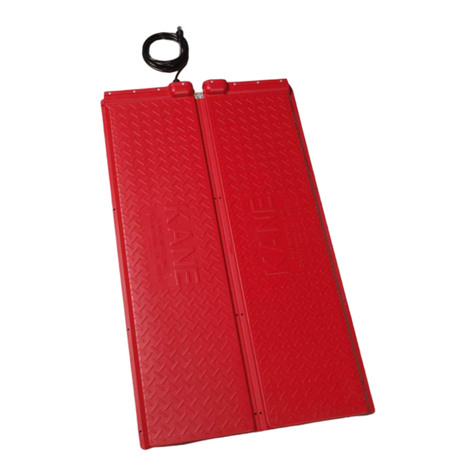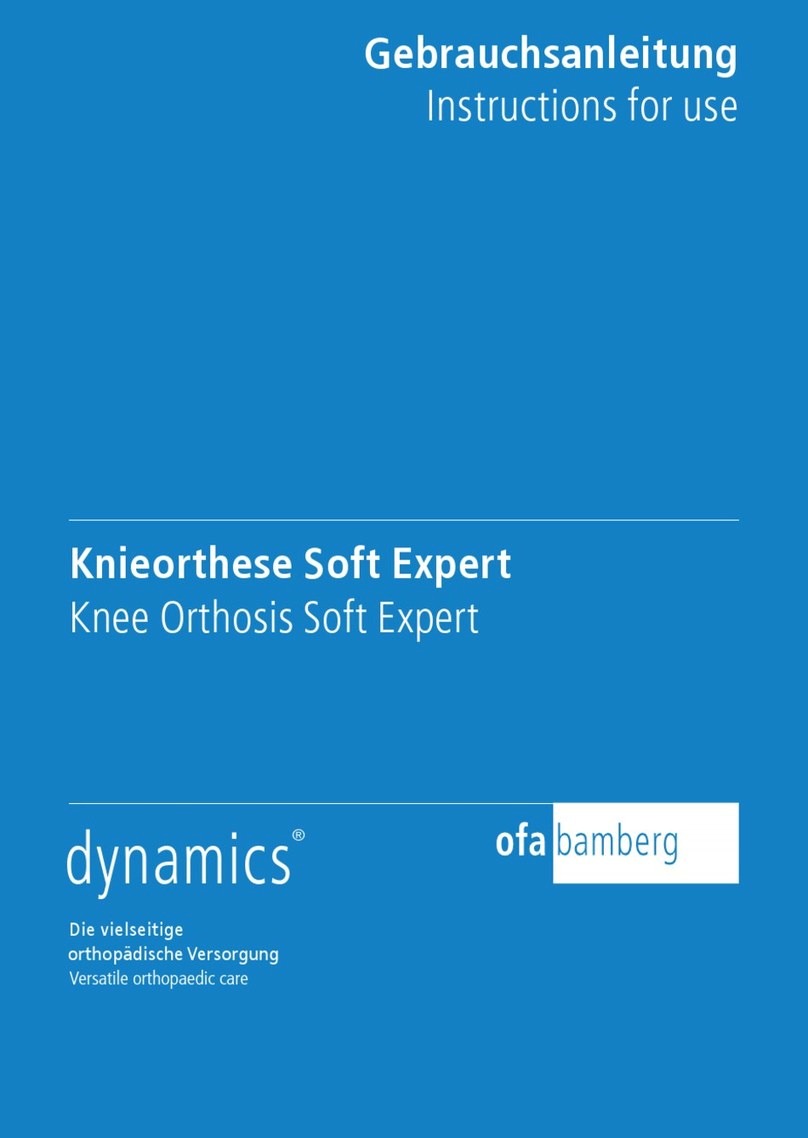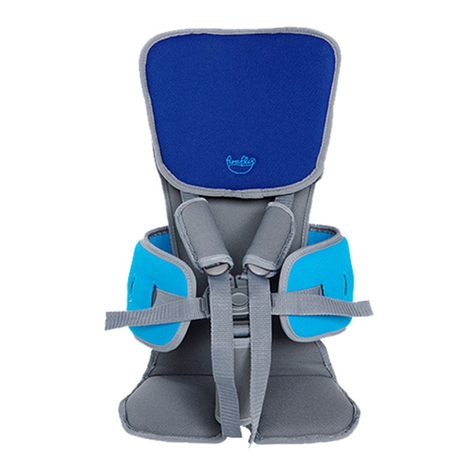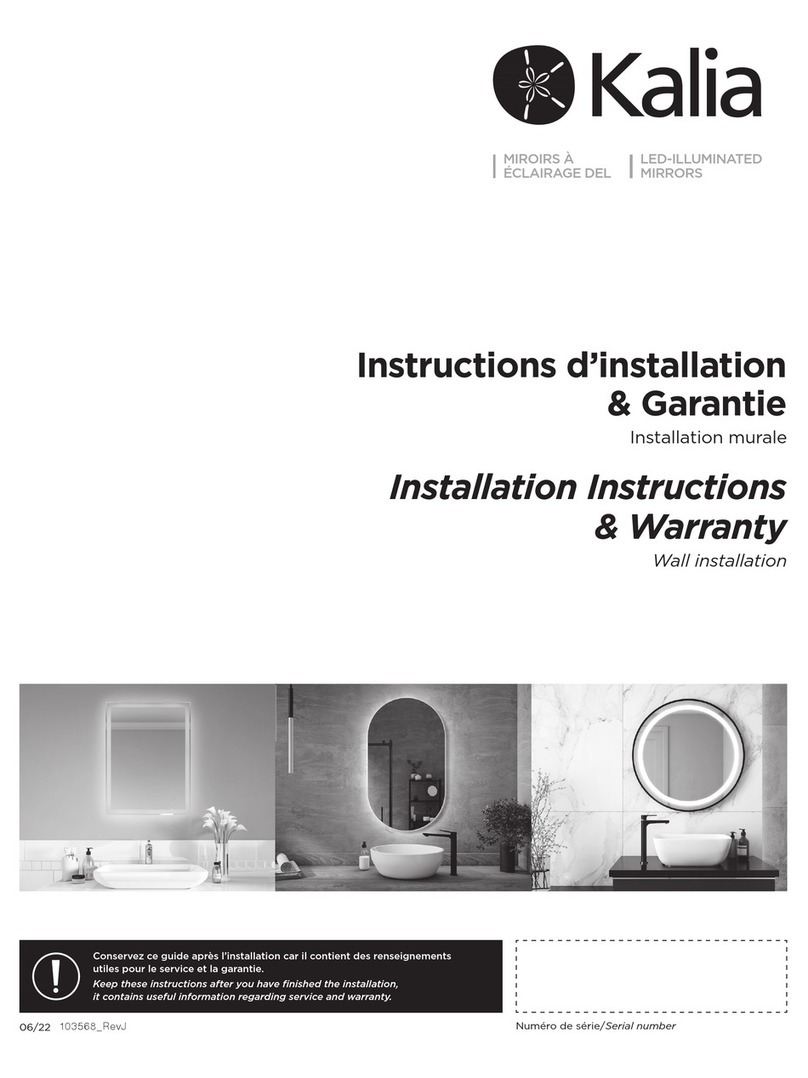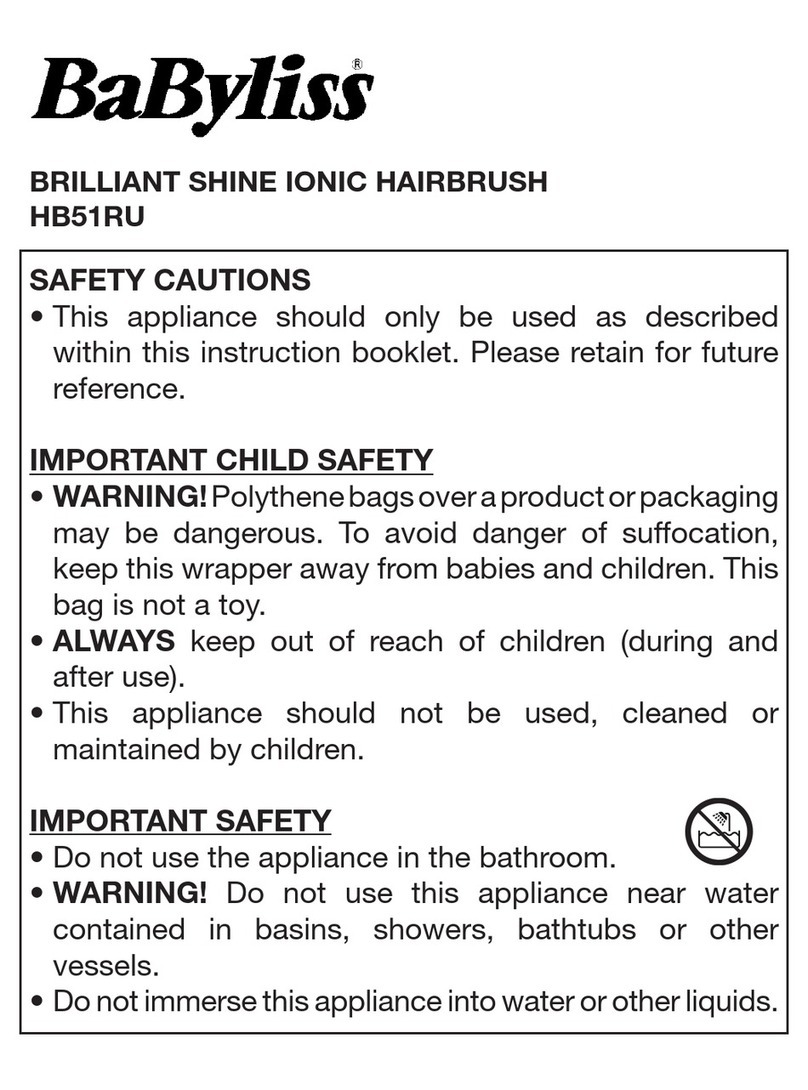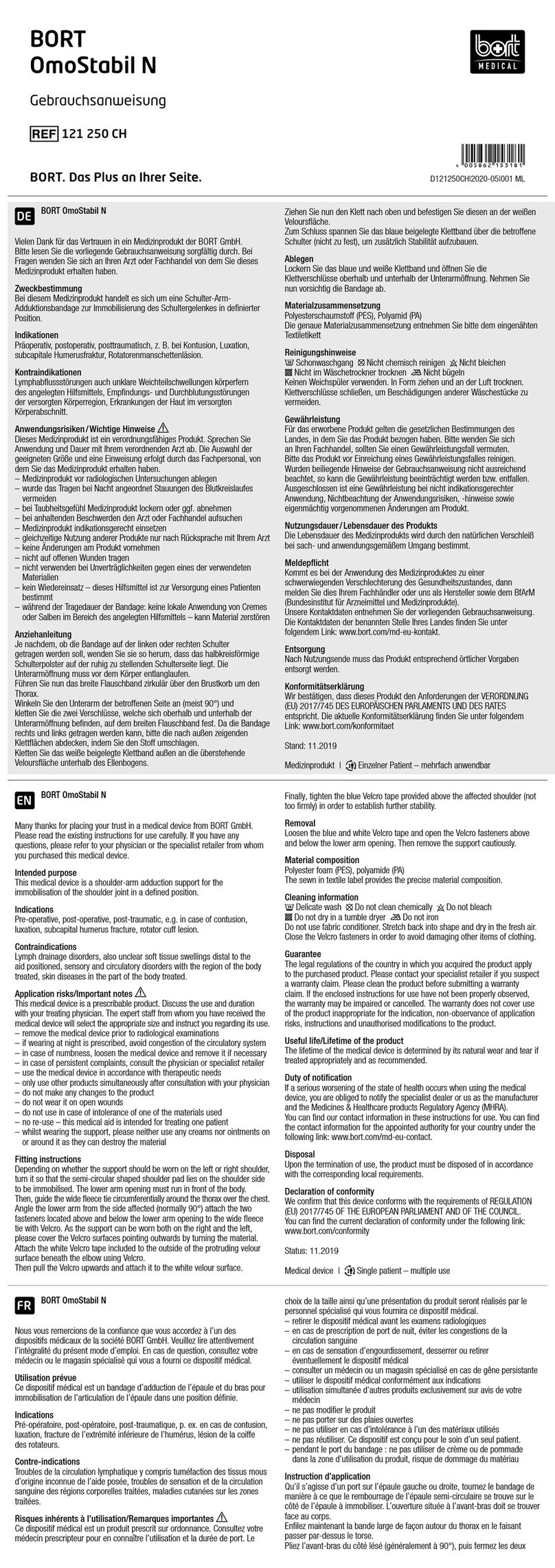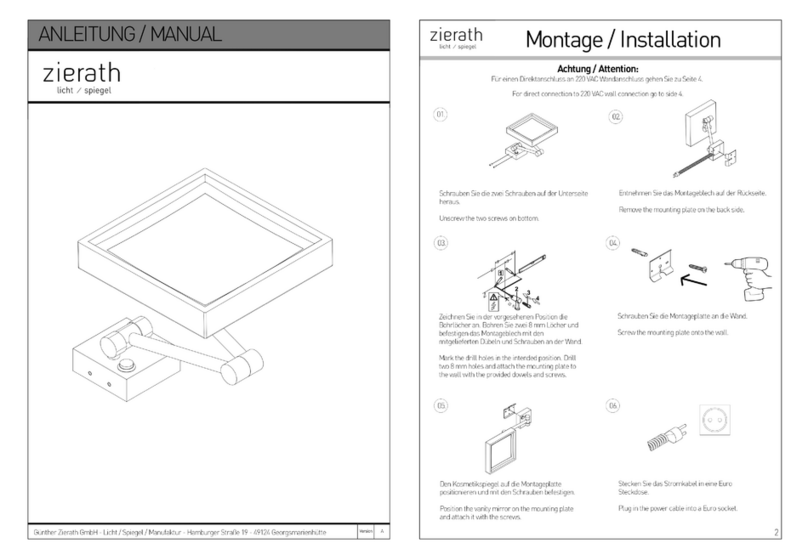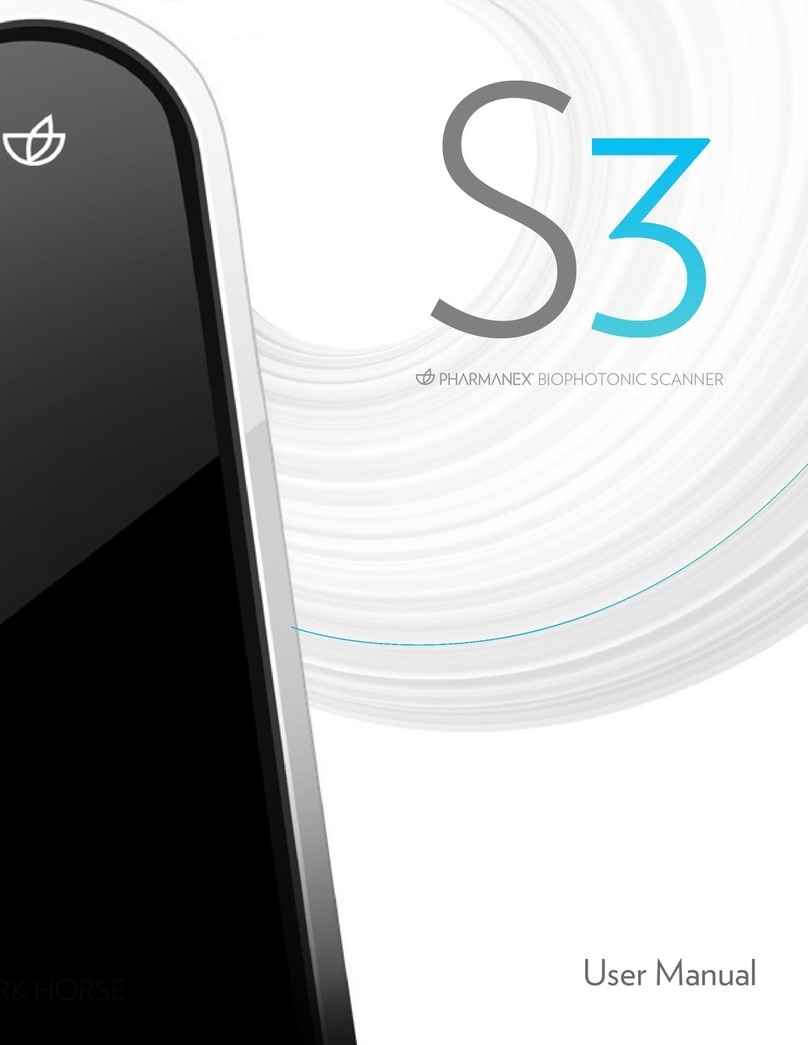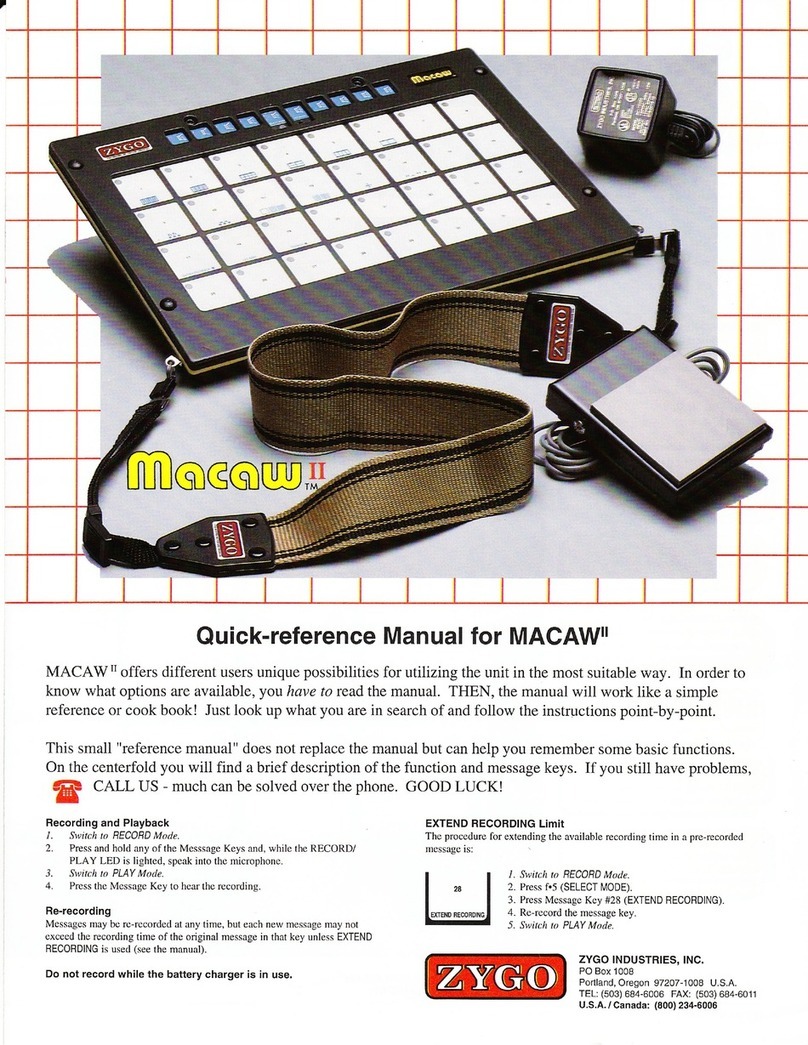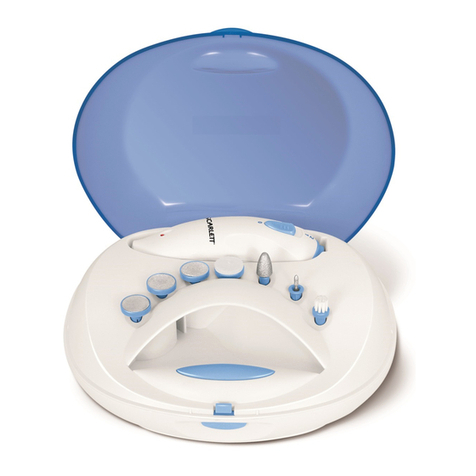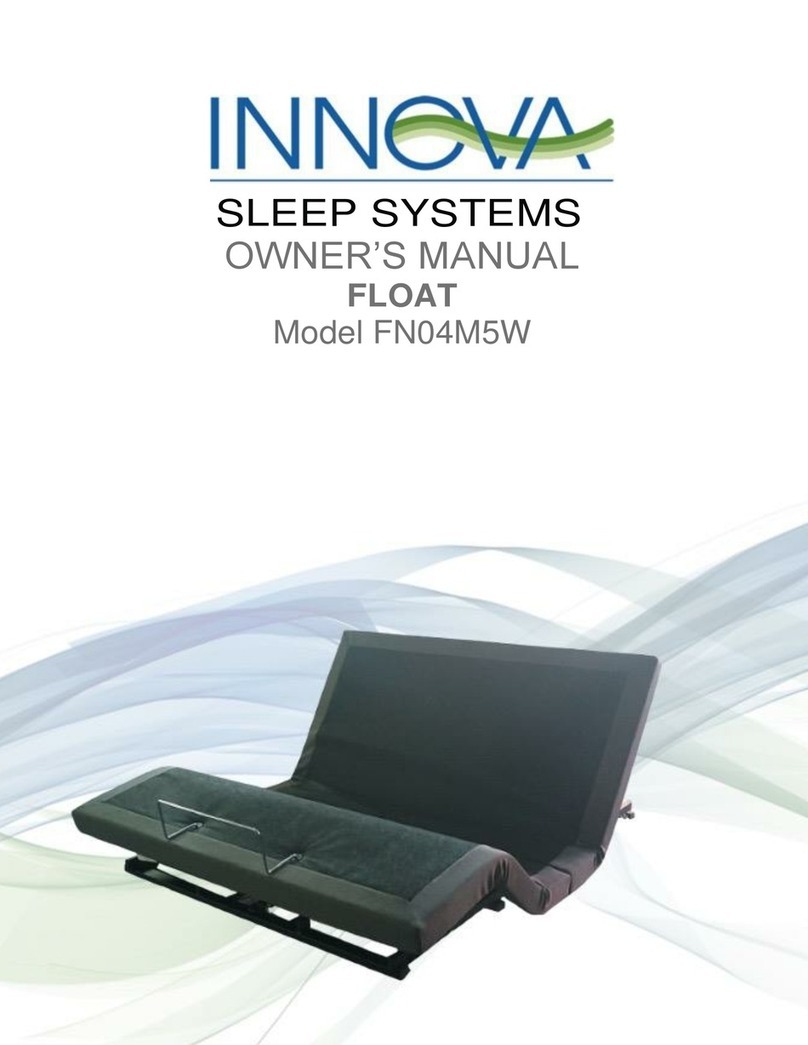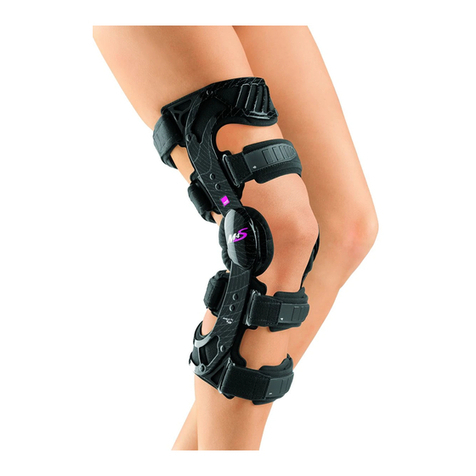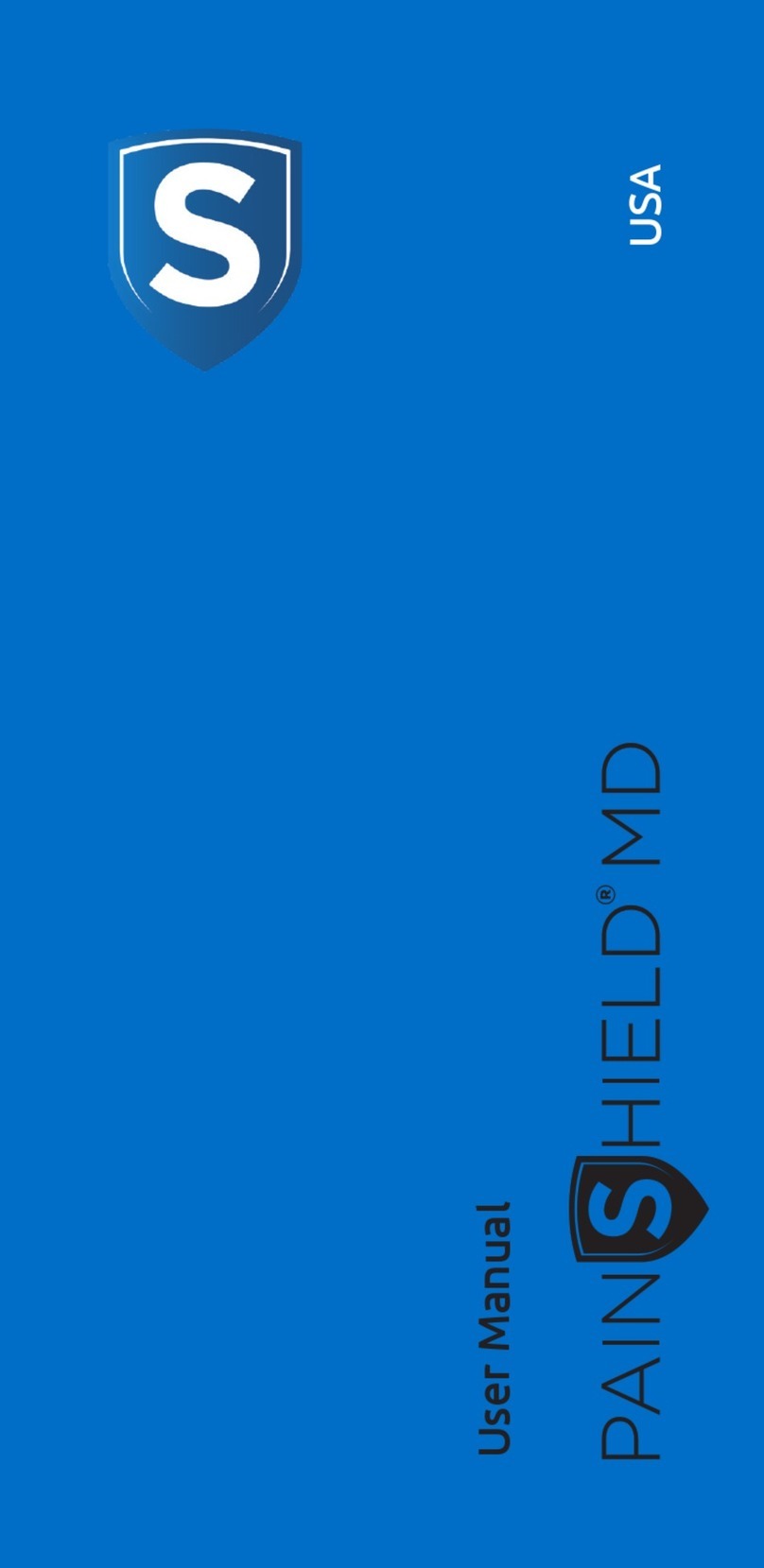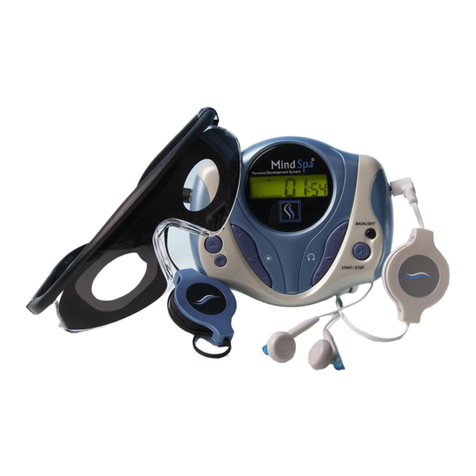Specialised Orthotic Services 3D MODULAR SEATING SYSTEM User manual

USER’S MANUAL
ALL USER’S OF THE EQUIPMENT SHOULD BE AWARE
OF THIS DOCUMENTAND ITS CONTENT
ISSUE 2
3D MODULAR SEATING
SYSTEM
|CLASS 1 DEVICE

1
Specication of the Seating System supplied.
Specied• belowarethedetailsoftheequipmentsupplied.
On
• thelisteachitemtickedisapartofyourSeatingSystemandoppositeeachitemis
thereferenceoftherelevantsectioninthisuserdocumentationforthatitem.
SeatingSystemReferenceNo. DateIssued://
WeightofSeatingSystemKg
User Manual Reference
Item Tick if
supplied No. of Items Supplied Page Section
3DCushion
Pommel
Kneeblocks
3DBackrest
LateralSupports
SacralPad
Adj-Headrest
Adj-Footrest
SeatingSystemType
Specifyanyotherfeatures; MaximumClientWeightLimitfor
SeatingSystem
Kg
Itisrecommendedthatthis
equipmentisonlysuitableforuse;
Indoor Indoor&
Outdoor
Detailsofwheelchair(s)approvedforusewiththeSeatingSystem.
Model of Wheelchair Wheelchair Manufacturers
Reference Number Tested at (Specify Angle)
1pieceunit 2pieceunit

2
Index
CONTENTS PAGE
Specication of Seating System 1
Index 2
Introduction 3
Clinical Review 4
Stability of Wheelchair and Seating Systems4-5
Recommendations on Transport6-9
1.0 User’s Guide “Fitting the 3D Modular System to the wheelchair”
1.1 Locatingthe3DModularSystemFrame 10-13
1.2 3DModularSupportPads 14
1.3 ElectricWheelchairUse14
1.4 MaintainingtheWheelchair 14
2.0 User’s Guide “Lifting and Handling the Client”
2.1 LiftingandHandlingtheClientinandoutofthe3DModularSystem 15
2.2 ClientStraps,Harnesses 16
2.3 FootrestAdjustment 16
3.0 User’s Guide “Maintenance of the 3D Modular System”
3.1 Cleaningthe3DModularSystem 17
3.2 Cleaningthe3DModularSystemCovers 18
3.3 Harness,Pads&Straps 18
3.4 VisualInspection 18
3.5 FireRetardancy 18
4.0 User’s Guide “Optional Features”
4.1 AdjustableHeadrest 19
4.2 AdjustableFootrest 20
4.3 DetachablePommel 21
4.4 Kneeblocks 22
If You Detect a Fault or Breakage 23
CONTACT DETAILSBackpage

3
3D MODULAR SEATING SYSTEM
(Class 1 Device)
Introduction
The• 3DModularSeatingSystemisaModularSeatingSystemintendedforusewith
StandardWheelchairs.
The
• maintenanceandsafetyinstructionsdescribedinthismanualshouldbeadhered
to.Byfollowingtheseinstructionsyouwillbeensuringcorrectuseofthe3DModular
System.
The
• 3DModularModularSeatingSystemisaClass1Devicewithacustomisedinsert
intendedforusebyaparticularclientandshouldnotbeusedforanyotherclient.
The
• assessmentastothelevelofsupportrequiredbyaclientwillnormallybedone
throughaSpecialSeatingClinicorganisedbyyourWheelchairService.
Each
• systemismanufacturedforusewithaparticularwheelchair(s).Tomakesure
usingthe3DModularSystemdoesnotrenderthewheelchairunsuitable,the3D
ModularSystemandwheelchairshouldbetestedforstabilitywiththeclientseatedin
theequipment(formoredetailsregardingstabilityofwheelchairandseatingsystems,
seepage4).
As
• withmostSeatingSystemsitisadvisabletomonitoraclient’sinitialuseofthe3D
ModularSystemintheearlystagesofitsuse.Itisrecommendedthatthetimeaclient
sitsinthesystemiscontrolled,thiswillvaryduetocircumstances,butwherepossible
periodsofsittinginthesystemshouldnotexceedmorethan3hoursatanyonetime.
Removing
• theclientfromthesystemisadvisedaftersuchaperiodtoofferachangeof
posture.Bydoingthisyouwillimproveaclientstolerancetosittinginthe3DModular
Systemonadailybasis.
It
• isalsoimportanttoreadthe‘WheelchairUserManual’withregardtogeneraluse,
transportationuseandmaintenance.
Basic Components of the
3D Modular System
LateralPads
SacralPad
Cushion
Pommel
Headrest
Backrest
RetentionStraps
HipPads

4
Clinical Review
• Toensurethe3DModularSystemcontinuestomeettheclinicalrequirementsofthe
client,itisrecommendedthatthesystemisreviewedbytheSpecialSeatingClinicat
leastonceayear.
This
• maybedoneautomaticallybyyourDistrictWheelchairService.
If
• aclienthashada3DModularSystemover12monthsitisrecommendedthatyou
contacttheDistrictWheelchairServicesforareview.Thiswillensurethatthe3D
ModularSystemismaintainingtheclinicalneedsoftheclient.
Stability of Wheelchair and Seating Systems
• Toensurethatthe3DModularSystemandwheelchairaresafetouse,itisimportant
thatttingthe3DModularSystemtothewheelchairdoesnotmakethewheelchair
unstableduringnormaldailyuse.Each
3DModularSystemwhenhandedoverto
theuserwillbetestedforstabilitytothe
relevantangleofstabilityforthechairto
betested.
The
• recommendedmaximumangleof
tiltis12degreesforattendanttransit
wheelchairsand16degreesforusers
ofselfpropellingwheelchairsand16
degreesforusersofelectricindoorand
outdoorelectricwheelchairs.
If
• theclientisgoingtouseadditionalitems
mountedtothewheelchairorseating
systemsuchascommunicationsaidsetc.,
thenitisessentialthatthetestbedone
withtheseinsitutoaccesstheirimpact
onthesafetyofthewheelchair.Similarly,
simpleitemssuchastraysneedtobeinplaceforthetesttotakeintoaccountallthe
equipmenttobeusedbytheclient(seediagramopposite).
The
• stabilitytestisalwaysdonewiththeclientseatedintheseatingsystemandall
equipmenttobeusedbytheclientonadailybasiswheninthewheelchairinsitu.The
combinedclientSeatingSystemandwheelchairassemblyistestedtothespecied
maximumangleoftilt.
Once
• thetesthasbeensuccessfullycompletedaStabilityCerticatewillbeissued
bySpecialisedOrthoticServicesLimited.Acopyofthiscerticatewillbehandedover
whentheequipmentissuppliedandshouldbekeptwiththeusermanualforfuture
reference.
16°
12°

5
Stability of Wheelchair and Seating Systems (Cont.)
The• 3D Modular System is not to be used with any other wheelchair(s) than
those for which it has been stability tested and proven safe for use.
Always
• steer clear of obstacles where possible.
When
• using the equipment never attempt to climb or descend an incline where
the surface is rough, wet or slippery (gravel, loose chippings, grass, rain, ice,
snow, etc).
If
• the equipment is to be used in an electric wheelchair then read carefully the
wheelchair manufacturers instructions with regard to safety.
WARNING:
• Whilst the client is seated in the wheelchair, the attachment of any
heavy object to the wheelchair (i.e. shopping bags etc.) will have a serious effect
on the overall stability of the wheelchair and may place the safety of the client at
risk.

6
Recommendations for the
Transportation of SOS Seating Systems
The following information is intended to give guidance with regard to the use of SOS
Seating Systems by wheelchair users and carers during transportation.
Specialised• Orthotic Services Ltdhavecarriedoutextensiveinvestigationsintothe
suitabilityofourSpecialSeatingSystemsfortransportationuseandhasestablished
clearguidelinesforusers.
Following
• theseinvestigationsthefollowinguserinformationisintendedtogive
guidancetousersofSOSSeatingSystemsregardingtheuseoftheequipmentduring
transportation.
All
• SOSSeatingSystemsareprescribedviaSpecialSeatingClinicsandduring
theassessmentprocessthewheelchairtobeusedwiththeSeatingSystemwillbe
identied.
As
• partoftheassessmentprocess,transportationrequirementswillbeassessedand
asuitablewheelchairprescribedforusewiththeSeatingSystem.
This information will be of interest to all parties involved in the daily management of
the wheelchair user (Relatives, Carers, Support Staff, Healthcare Professionals and
Transport Service Providers).

7
General Safety Guidelines for
Wheelchair User Transportation
Wheelchairusersshouldtransfertovehicleseatswheneverpossible.•
Wheelchair• usersshouldnottravelwiththewheelchairatanangleorfacingsideways
tothedirectionoftravel.
There
• shouldbesufcientfreespacearoundthewheelchairandusertoavoidthe
usermakingcontactwithothervehicleoccupants,unpaddedpartsofthevehicle,
wheelchairaccessoriesorW.T.O.R.S.anchorpoints.
Wheelchairs
• shouldhavetheparkingbrakesappliedandtheirpowerunitsswitchedoff
duringvehiclemovement.Poweredwheelchairsshouldnotbeleftinfreewheelmode.
Wheelchairs
• shouldnotblockgangwaysandexitsforotherpassengersinthevehicle.
A
• headrestshouldbeprovidedforawheelchairuserwhentravellinginavehiclewhere
otherseatedpassengershaveheadrests.
Do
• notplace/hanganyadditionalitemsontothewheelchairduringtransportation
suchasshoppingbagsandholdalls.
Trays
• shouldberemovedfortransportationwheneverpossible.Ifitisnecessaryfora
traytobeusedontransportation,thenariskassessmentshouldbedone.
Wheelchair Tie Down and Occupant Restraint System
(W.T.O.R.S.)
Securemethodsforthesaferetentionofwheelchairshavebeendevelopedandare•
usedonaregularbasistosecurewheelchairsduringtransportationuse.
These
• systemsarenowcommonlyreferredtoasW.T.O.R.S.
Wheelchair Tie down and Occupant Restraint Systems
TherearemanytypesofW.T.O.R.S.availablefromvariousmanufacturers(alistof•
somemanufacturersisgivenonpage9).RefertoyourWheelchairManufacturers
Handbookfordetailsoftheirparticularrecommendations.
Please
• notethatalllap/chestbeltsandharnessessuppliedwiththeseatingsystem
are notsufcientforoccupantrestraintwhentheequipmentisusedonamoving
vehicleandadditionalOccupantRestraintisrequired.

8
Use of Seating System in a
Wheelchair for Transportation
To make sure that the seating system and wheelchair are used effectively and safely
for transportation use, the following recommendations are provided for:
TheSeatingSystem-WheelchairInterface•
TheWheelchairTiedownSystem•
TheOccupantRestraintSystem•
1. WHEELCHAIR TIE DOWN SYSTEM
Wheelchair• users should not travel in cars, taxis or minibuses, unless the
wheelchair is tied down.
Please
• refertoyourwheelchairusersguideforinformationregardingthe
recommendedwheelchairtiedownsystemtobeused.
Only
• thewheelchairspeciedforusewiththeseatingsystemcanbeused.
2. OCCUPANT RESTRAINT SYSTEM
Wheelchair• users should not travel in cars, taxis or minibuses, unless an
occupant restraint system is in place on the client.
For
• anyclienttobetransportedsafelyintheSeatingSystemandwheelchair,itis
essentialthatanOccupantRestraintSystembeused.
SOS
• haveprovenduringcrashtestson3DModularSystemsthattransportingany
clientonamovingvehiclewithoutanapprovedoccupantrestraintsystemisextremely
dangerousandwillplacetheclient at great risk.
It
• isimportantthattheOccupantRestraintSystemispositionedcorrectlyasmost
clientsusingSpecialSeatingwillbedependentoncarersforcorrectplacementofthe
occupantrestraint.
Consideration
• shouldbegiventothemostsuitabletypeandpositioningofrestraintfor
theuser,bothinnormaltravelandduringanimpact.
The
• OccupantRestraintshouldhaveaclearpathfromtheusertotheanchorpoint
andshouldnotbeinterferedwithbyanypartofthevehicle,wheelchair,seatingor
accessory.

9
Stowage of the Seating System and Wheelchair
DuringuseofyourSpecialSeatingSystemitmaybenecessaryforyoutoremovethe•
SeatingSystemandstowthisalongwiththewheelchairinavehicle.
It
• isimportanttorealisethattheseitemsposeariskifnotadequatelyrestrained
whilstintransit.
It
• isnotadequatetosimplyplacetheitemsintoacarbootortheoorofanopen
vehiclesuchasanMPVorestatecarasinacollisiontheseunsecureditemscould
causeserious injurytooccupantsofthevehicle.
Various
• retentionmethodsareavailabletosecuresuchequipmentduringtransit,and
onceagainthelistofWheelchairRestraintSystemManufacturersinthisbookletwill
behappytoadviseonthismatter(seebelow).
W.T.O.R.S MANUFACTURERS
Below are details of some Wheelchair Tie down and Occupant Restraint Systems
manufacturers.
UNWIN SAFETY
SYSTEMS
UnwinHouse
TheHorseshoe
CoatRoad
Martock
Somerset
TA12 6EY
TEL:01935827740
FAX:01935827760
EMail:sales@unwin-safety.co.uk
KOLLER
ENGINEERING LTD
Unit5,GarrettRoad
LynxTradingEstate
Yeovil
Somerset
BA202TJ
TEL:01935426695
FAX:01935433766
EMaiI:enquiries@koller.co.uk
QSTRAINT
(EUROPE)
Unit175
JohnWilsonBusinessPark
Whitstable
Kent
CT53RB
TEL:01227773035
FAX:01227770035
EMaiI:[email protected]
SAFETEX Unit16/17
BookhamIndustrialPark
ChurchRoad
Bookham
Surrey
KT23 3EU
TEL:01372451272
FAX:01372451282
EMail:[email protected]

10
USER GUIDE 1.0
THE SEATING SYSTEM WHEELCHAIR INTERFACE
The• 3DModularSystemwillhavebeenbuilttosuitthewheelchairspeciedatthe
assessment.Themethodofinterfacingtheseatmayvaryandthe2typesofinterface
optionsaredescribedinthissection.
• The standard3DModularsystemconsistsofabackrestandcushionassembledintoa1
pieceor2piecesystem.Toattachthe3DModularsystemtotheappropriatewheelchair,
pleasefollowtheinstructionsforboth1pieceand2piecesystems.
1.1. LOCATING THE 3D MODULAR SEAT FRAME
CANVAS FITTING INTERFACE METHOD (1 piece system)
Ifthe3DModularSystemhasbeensetuptointerfaceontheexistingwheelchaircanvases
thenthefollowingmethodisusedtoinstallandremoveitfromthewheelchair.
Whilst• holdingthe3DModularSystem,placethis
intothewheelchairmakingsurethatthefrontbar
onthesupportframelocatesbehindthearmrest
uprightposts(Fig.1.1a)orintotheskibrackets(if
tted).
Having
• locatedtheseatbehindthearmrest
uprightsgentlylowerthebackoftheseatonto
thewheelchairbackrestcanvas.Theseatwill
nowbeabletositintothewheelchair.
The
• seatretentionstrapsnowneedtobe
fastenedaroundthebackofthewheelchair.
There
• arebetween1&3retainingstraps
(Fig.1.1c)tosecurearoundthewheelchaironthe
1piece3DModularSystem(dependingonwheelchair).
Seat
• RetentionStrapsaresecuredaround
thebackofthewheelchairframe,notjustthe
wheelchaircanvas(Fig.1.1b).
With
• the3DModularSystemnowinstalledinto
thewheelchairitisnowsafetoplacetheclientin
position.
S.O.S.
• Seating Systems need to be interfaced
to the wheelchair safely and it is important
that the retention straps are always secured
for client safety.
Removing
• the3DModularSystemfromthe
wheelchairisthereverseoftheaboveprocedure.
Fig.1.1a
Fig.1.1b

CANVAS FITTING INTERFACE METHOD (2 piece system)
Ifthe3DModularSystemhasbeensetuptointerfaceontheexistingwheelchaircanvases
thenthefollowingmethodisusedtoinstallandremoveitfromthewheelchair.
Whilst• holdingthecushionofthe3DModularSystem,placethisintothewheelchair
makingsurethatthefrontbaronthesupportframe(iftted)locatesbehindthe
armrestuprightposts(Fig.1.1a)orintotheskibrackets(iftted).
Having
• locatedthecushionintothewheelchair,Placethe3DModularbackrestinto
thewheelchairontopofthecushionandupagainsttherearcanvass.
Once
• thebackrestisinpositiononthecushiontheseatretentionstrapsnowneed
tobefastenedaroundthebackofthewheelchair(DoNotfastenthesecuringstraps
beforethetwopiecesareinthewheelchair).
There
• are3retainingstraps(Fig.1.1d)tosecurearoundthewheelchaironthe2piece
3DModularSystem.
Seat
• RetentionStrapsaresecuredaroundthebackofthewheelchairframe,notjust
thewheelchaircanvas(Fig.1.1b).
With
• the3DModularSystemnowinstalledintothewheelchairitisnowsafetoplace
theclientinposition.
SOS
• Seating Systems need to be interfaced to the wheelchair safely and it is
important that the retention straps are always secured for client safety.
Removing
• the3DModularSystemfromthewheelchairisthereverseoftheabove
procedure.
11
1
2
Fig.1.1c
1
2
3
Fig.1.1d

12
HANGER BRACKET INTERFACE METHOD
Ifthe3DModularSystemhasbeensetuptointerfaceintothewheelchairwithLocation
HangerBracketsthenthefollowingmethodisusedtoinstallandremoveitfromthe
wheelchair.
Firmly• holdingthe3DModularSystemlower
itintothewheelchair.Asyoulowertheseat
intothewheelchairpleasenotethatunderthe
supportframeontheseatingsystemyouwillsee
someadditionalbrackets,thesearetheLocation
HangerBracketsandareintendedtositonto
theseatrailsofthewheelchair.Gentlylower
theseatingsystemintopositionmakingsure
thattheHangerBracketslocateontheseatrails
(Fig.1.1e).
Having
• loweredtheseatontotheseatrailsand
locatedtheHangerBracketstherearoftheseat
needstolocateontothebackofthewheelchair.
Slidetheseatingsystembackontheseatrails
untiltherearLocationHangerBracketsits
againstthebackrestofthewheelchair.
With
• theseatingsystemHangerBracketslocated
ontheseatrailsandthebackrestpostsofthe
wheelchairitisnownecessarytoslidethe
HangerBracketlocktubesintopositionwhere
tted(Fig.1.1f).
With
• thelockingtubesinpositiontightenthe
lockingscrewstosecurepermanently.
Having
• attachedallthehangerbracketsinto
positionasdescribedaboveallthatremainsto
bedoneistottherearretentionstraps(onthe
supportframeoftheseatingsystem)aroundthe
backofthewheelchairandsecureinposition
(Fig.1.1g).
The
• seatisnowreadytouse.
Special
• Seating System Restraint Straps must
always be in position and tightened rmly.
This is essential during transportation of the
client, to ensure client safety.
Check
• tightness of these straps regularly.
loose straps are potentially dangerous and
may not secure the 3D Modular System
properly.
To
• removetheseatingsystemfromthe
wheelchairsimply,reversetheaboveprocedure.
Fig.1.1e
Fig.1.1f
Fig.1.1g

13
QUICK RELEASE (Quick-Loc) INTERFACE METHOD
Whilst• holdingthe3DModularSystem,placethis
intothewheelchairmakingsurethatthefrontof
theinterfaceframelocatesintostopsasshown
(Fig.1.1h).
Lower
• thebackoftheseatintothewheelchair
untiltheinterfacelocatesintotherearcatchesas
shownanditclicksintoposition(Fig.1.1j).
SecuretheSeat
• RetentionStrapsaround
thebackofthewheelchairframe,notjustthe
wheelchaircanvas(Fig.1.1k).
With
• the3DModularSystemnowinstalledinto
thewheelchairitisnowsafetoplacetheclientin
position.
S.O.S.
• Seating Systems need to be interfaced
to the wheelchair safely and it is important
that the retention straps are always secured
for client safety.
Before
• removingthe3DModularSystem,SOS
recommendthattheclientisremovedfromthe
seatingsystem.
Toremove
• the3DModularSystemfromthe
wheelchair,releasetheretentionstrap,pullback
theinterfaceleverorcable(Fig.1.1m)untilthe
catchesrelease,raiseuptherearoftheinterface
clearofthecatches,releasetheleverandpull
theinterfaceclearofthefrontstops.
Fig.1.1k
Fig.1.1h
Fig.1.1j
Fig.1.1m

14
1.2. 3D MODULAR SEAT SUPPORT PADS
All• thesupportpadsttedtothe3DModularSystemareattachedbyVelcro.Thepads
havettedcoversandthesecanberemovedbysimplyunzippingthecover.
1.3. ELECTRIC WHEELCHAIRS
When• ttingthe3DModularSystemtoanelectricwheelchair,thettingprocedures
arethesameasin1.1.
However
• itisalsonecessarytomakesurethatanyelectriccablesetc.,arenot
trappedorjammedbythe3DModularSystemduringplacementintoanelectric
wheelchair.
1.4. MAINTAINING THE WHEELCHAIRS
It• isimportantthatthewheelchairmanufacturersguidelinesformaintenanceare
carriedout.
Under
• inatedtyresorfaultybrakesetc.canrenderawheelchairdangerousifused
withsuchfaults.
All
• newwheelchairsaresuppliedwithacopyofthemanufacturersuserinstructions.
You
• shouldhaveacopyoftheWheelchairManufacturersUserInformation.
If
• youdonothaveacopy,contactyourWheelchairServicetoobtainacopy.
Always maintain your wheelchair as per manufacturers instructions.

15
USER GUIDE 2.0
2.1. LIFTING & HANDLING THE CLIENT IN & OUT OF THE 3D MODULAR SYSTEM
Most• usersof3DModularSystemswillneedtobehoistedintotheequipment.
Manuallyliftingtheclientisnotrecommended,howeverwithsomeclientsitmaynot
bepossibletohoistthemsafelybyconventionalmeansandininstancessuchas
thisyouarerecommendedtocarryouta‘RISK ASSESSMENT’toassesstherisks
involvedinanysuchaction.
It
• isimportantthatallcarersareawareoftheHealth&Safetyguidelinesfor‘Lifting
and Handling’.
Before
• liftingtheclientmakesureallstrapsareplacedoutofthe3DModularSystem.
Thiswillavoidthestrapsbecomingtrappedundertheclientwhenseated.
When
• usingthehoist,makesurethatyoufollowthehoist manufacturers
instructionsregardingcorrectuse.
On
• loweringtheclientintothe3DModularSystemmakesurethattheclient’ships/
pelvisarelocatedasfarbackaspossibleintotheseat.
Leaving
• thehoistslinginthe3DModularSystemoncetheclienthasbeenplaced
isnotrecommendedasthiscouldcausediscomfortandpressureareastobe
generated.However,ifanymanagementissuesrequiretheslingtobeleftinsitu
thenitisrecommendedthatthemostappropriateslingbeused.Ifyourequirefurther
informationregardingthis,contactyourlocalWheelchairServiceTherapist.
Please
• note, that it is very important that the client is correctly positioned to
give maximum comfort and support.

16
2.2. CLIENT STRAPS / HARNESSES
• Secureallstraps/harnesssupplied.Straps
andharnessmustbetightenedtowork
correctly.
It
• isdangeroustohavestrapstoolooseor
notinplaceontheclient.
If
• the3DModularSystemhasbeentted
witha‘ButteryXHarness’,itisimportant
thatitiscorrectlyadjustedtomaintainsafe
clearanceatthetopoftheharnessas
illustratedinthediagramoppositeat‘X’.
2.3. FOOTREST ADJUSTMENT
It• isrecommendedthatfeetbesupportedon
thefootsupportsprovidedtoensurethatthe
clientisseatedwithoptimumcomfort.
Leaving
• theclientsfeetunsupportedisnot
recommendedasthiscanleadtogreat
discomfortandabnormalpressurebeing
generatedatthepelvisandotherweight
bearingareas.
It
• isthereforeessentialthatthefootrestsof
thewheelchairbeadjustedcorrectly(see
WheelchairUserManualfordetails).
Keep bottom straps of
harness tight.
‘X’

17
USER GUIDE 3.0
MAINTENANCE OF THE 3D MODULAR SYSTEM
Tomakesurethatthe3DModularSystemremainssatisfactoryitisnecessarytocarryout
simplemaintenance.
3.1. CLEANING THE 3D MODULAR SYSTEM
During• usethe3DModularSystemwillrequirecleaning.Thiscanbedonebysimply
applyingawarmdampclothwithamilddetergenttotheinsidesurfaceoftheseatto
removeanysoilingandtoweldry.Note:Thecovers/padsMUSTberemovedpriorto
anycleaningoftheseat.
If
• the3DModularSystemremainsslightlydampsimplyleaveforashortperiodat
roomtemperaturetodry.
The
• mouldedfoamsaresealedinaspecialwaterproofclearplasticprotectiveskin
whichalthoughwaterproofisairpermeabletoassistdailymanagement.Underno
circumstancesistheclearprotectiveskintoberemovedasthefoamwillhaveno
protectionagainstcontaminationandwillneedtobereplaced.Iftheplasticskin
becomesseriouslydamagedcontactSOSimmediately.Tocleanthemouldedpads,
simplywipedownwithmilddetergentandadampclothandtoweldryandleaveat
roomtemperaturetodrythoroughly.Undernocircumstancesuseexcessiveheattotry
todrythefoamasthiscoulddamagetheprotectiveskin.
The
• ancillaryFoampadsonthe3DModularSystemcanalsobemadefromanopen
cellfoam,whichwillabsorbwater.DO NOTgettheseexcessivelywetasthefoamwill
beaproblemtodry.
DO
• NOT PUT THE 3D MODULAR SYSTEM NEXT TO A HOT FIRE OR USE
EXCESSIVE HEAT TO DRY AS EXCESSIVE HEAT COULD AFFECT THE
COMPONENTS OF THE SEAT.
DO
• NOT USE SCOURERS OR CAUSTIC SUBSTANCES SUCH AS BLEACH

3.2. REMOVABLE COVERS
For• cleaningofremovablecoverspleaserefertowashlabelontheinsideofthe
paddedcover.
To
• removethecoverssimplyremovethepadsfromthe3DModularSystemandunzip
thecoveroneachpad.
DO
• NOT REMOVE THE FOAM FROM THE WATERPROOF LINER OR TRY TO
WASH IT AS THIS FOAM WILL ABSORB WATER AND WILL BE A PROBLEM TO
DRY OUT.
ANY• DEVIATIONS FROM THE ABOVE MAY AFFECT THE FIRE RETARDANCY OF
THE COVER(S).
3.3. HARNESSES, PADS & STRAPS
Make• sureallstrapsareingoodworkingorderandthatbucklesworkcorrectly.
If
• anyshowsignsoffrayingoranybucklesarebrokenorfaultycontactyour
WheelchairServiceimmediately,DO NOT ATTEMPT TO REPAIR.
Harnesses
• maybecleanedbyapplyingawarmdampclothwithamilddetergent,
DO NOT USE POLISH.
3.4. VISUAL INSPECTION
Every• 3-4weekschecktheconditionofthe3DModularSystemandwheelchair,
ifyounoticeanyfaultsorbrokenpartspleasenotifyyourWheelchairService
immediately,DO NOT ATTEMPT TO REPAIR.
Look
• atthetubularframesofthe3DModularSystemandmakesurethereareno
signsofdistortion,makesuretheyaresecurelyattachedtotheshelloftheseatand
therearenolooseattachments.
Make
• surethatallxingsaresecure,especiallyaftermakinganyadjustments.
Check
• theshelloftheseatforanysignsofseverewearandtear.Alsothefoamlining
oftheseat.
3.5. FIRE RETARDANCY
Fire• retardantmaterialshavebeenusedintheconstructionofthisseatingsystem.
It
• isimportantthatnoaccelerantsareintroducedtothematerials(e.g.Hairspray,fabric
cleaners,deodorants,polishetc..),asthismayadverselyaffectthereretardancyof
yourequipment.
18

19
USER GUIDE 4.0
OPTIONAL FEATURES
4.1. ADJUSTABLE HEADREST
If• the 3DModularSystemhasbeenttedwithanadjustableheadrest,theheadrest
willhavebeenadjustedwhenthe3DModularSystemwasoriginallysupplied.
If
• anyadjustmentsneedtobecarriedoutthiscanbedonebyreleasingthelocking
knobsandadjustedforheight(Fig.4.1a)anddepth(Fig.4.1b),re-tightenlockingknobs
whennished.
PLEASE
• NOTE THAT SOS RECOMMEND THE HEADREST IS USED AT
ALL TIMES WHENEVER THE CLIENT IS BEING TRANSPORTED IN THEIR
WHEELCHAIR AND SEATING SYSTEM.
Fig.4.1a Fig.4.1b
Table of contents
Other Specialised Orthotic Services Personal Care Product manuals

Specialised Orthotic Services
Specialised Orthotic Services Custom Home Chair Moulded User manual
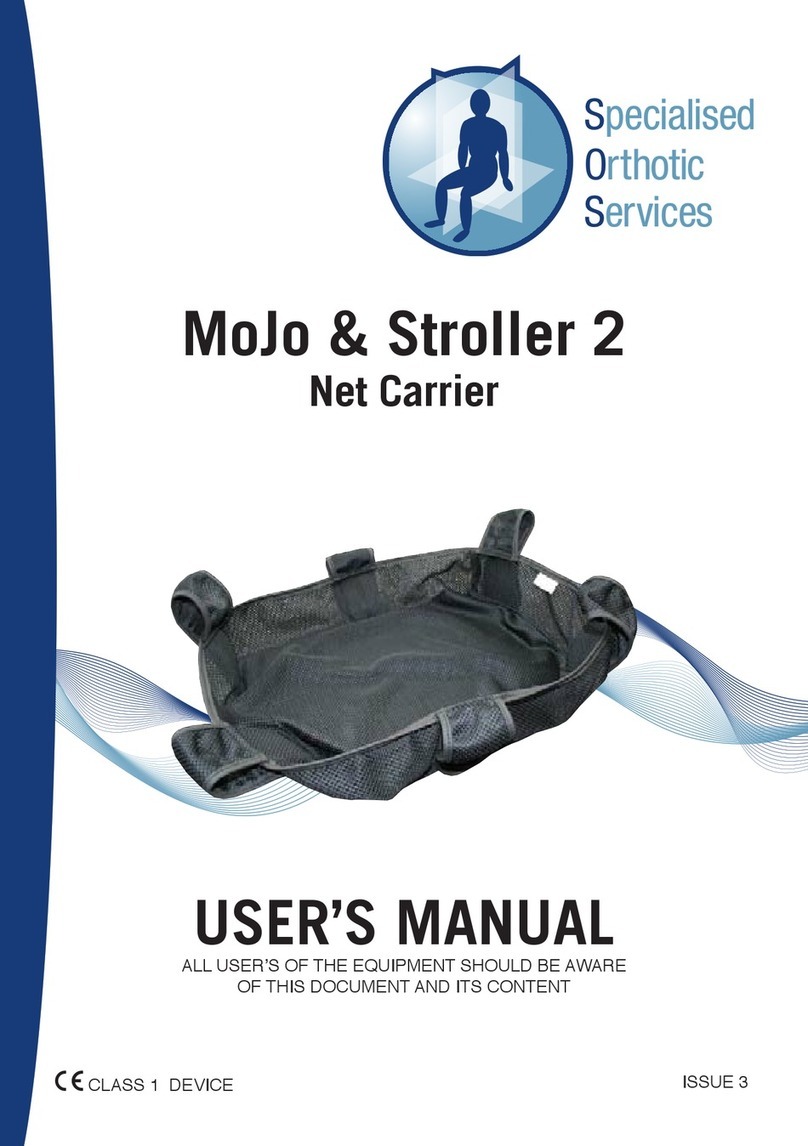
Specialised Orthotic Services
Specialised Orthotic Services MoJo & Stroller 2 User manual
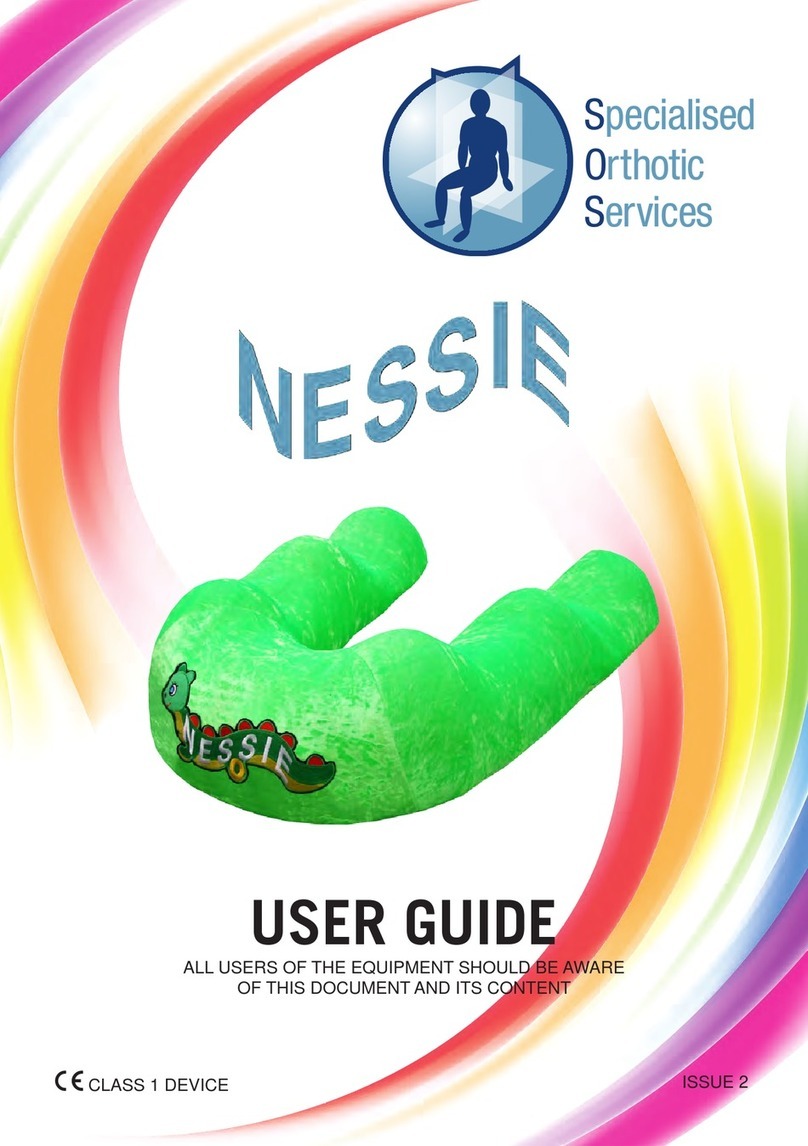
Specialised Orthotic Services
Specialised Orthotic Services NESSIE User manual

Specialised Orthotic Services
Specialised Orthotic Services ACHILLES HARNESS User manual


